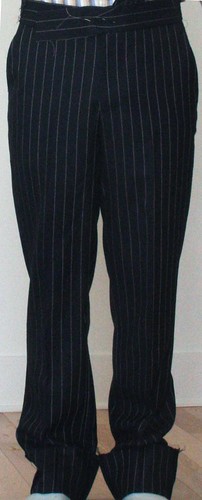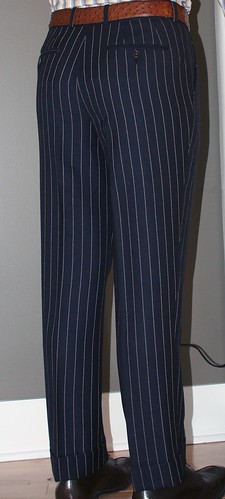If you're just joining us, back up one post first. We were discussing the ironwork involved in making trousers.
David asked what the difference would be between a trousers done with this ironwork and one done without. So the first fitting I sewed the seams straight with no manipulation, no fullness, no stretching, no shrinking, and the result was this. Not a very nice line. The hem is turned up at the bottom so it puddles around my ankles, but look more at how it hangs around my knees. Not clean
Then I ripped them down to show the ironwork in the previous post, and put them back together again. This is the result, which I much prefer.

While David is right, some of the shaping will be lost with wear, but I can put it back with a careful pressing. Those who steam their pants are ruining all this shaping and will have pants that puddle around their legs; by pressing them with a good iron and observing the shape illustrated in the T&C thread you can have a marked improvement in the fit of the leg.
UPDATE
To answer a few questions, the first thing that will help getting a better press on your trousers is a wider ironing board; normal household ironing boards are too narrow to fit the entire leg so you not only have a hard time visualizing the correct shape, but you also tend to do the front only and then shift the pant and then do the back (or vice versa) when you should really be doing the entire leg at once. The Rowenta board that I have at home (in the pictures) is great for this and has a much better pad than most domestic boards. I know that some department stores have followed their lead and started producing wider boards as well.
Next, some puddling around the legs can be from bad fit and can't be rectified by pressing; hip-forward posture or flat seats will cause cloth to puddle around the knees in a horse-shoe shape and no amount of pressing will fix that. But assuming you have a trouser that fits adequately, it also helps if the manufacturer has made provisions for this kind of shaping. As I mentioned, the knee notch is shifted so that when the seam is sewn the back thigh is sewn on tight to the front which has some fullness, and there is some fullness in the back calf area. This allows us to stretch the panel opposite the fullness, like when constructing the inseam of the two-piece sleeve, and work the trouser up when busting the seams (industry jargon for pressing the seams open). If this was not done (for expedience during production) you won't be able to get the full shape out of the trouser, but you will be able to help it a little. When pressing your trousers, always keep this shape in mind and your results will be much better.
Like any part of any garment, it helps to visualize the shape of the body which is being covered. The trouser is not really two straight creases- the leg makes a bit of an "s" shape so we will recreate this shape in the pant. Whenever we want to create a curve in a garment without a seam, we have to stretch the outer arc and shrink the inner one, so if you are dealing with misfigures, keep the person's shape in mind when shaping the garment. Refer to the diagram below- stretch over the front of the thigh, stretch the seam into a forward curve, and shrink the excess under the back of the thigh. Do the opposite on the lower half, working the curve into the shape of the calf. Notice that the creases are not straight and that the hem of the trouser will dip lower in the back than the front.
If and when I can get my hand on a video camera I will post video of the process with and without a vacuum table (which is a godsend).








10 comments:
The difference between the two versions is amazing. My trousers so far have mostly looked like the first version, as I haven't had instruction on correct pressing.
I saw the post on T&C, and my question is, is it okay to just follow the instructions as written, or do you make adjustments to the pressing techniques based on an individual body? For example, a bow-legged person, vs an average figure.
Thank you. I'm going to practice doing this also.
Amazing comparison.
What's the trick for touch-up pressing on the completed pant (or one that never had this care before being finished)? Do you need a sleeve board to shrink/stretch one side of the panel at a time?
I'm wondering if I can clean up some of my pants with this pressing.
Is this same technique applicable to 2 piece sleeves?
To go back to the man vs. machine comparison, do any trouser makers use custom-molded vacuum tables to instantly shrink/stretch the pants panels before they are sewn together? Like they have for pressing the shoulders and backs of jackets.
Most manufacturers try to reduce the number of operations where possible; to shape with an iron, them seam, then press the seams again can be reduced to just seaming and then doing the shaping at the same time as opening the seams so I think avoiding the dedicated press would be the way most would go. Sometimes it's unavoidable, like the blades and the collar. But it is possible that some purists do the shaping first; if money were no object, it's the way I would do it.
That's a nice ostrich belt you are wearing. Might you be able to share the maker?
Thanks, Daniel
It's from Reptile's House in Milan.
J
Great!
I really like your blog and you have shared the whole concept really well. And Very beautifully soulful read, thanks for sharing.
GROOM TUXEDO SUIT
Post a Comment